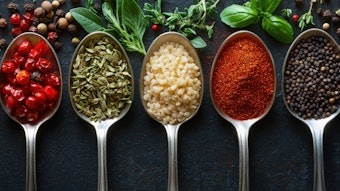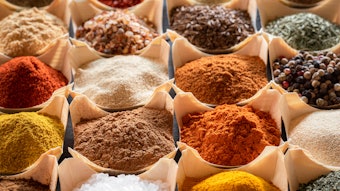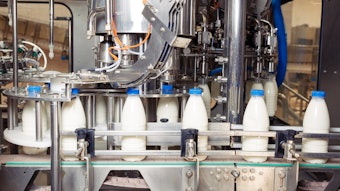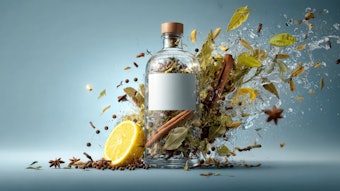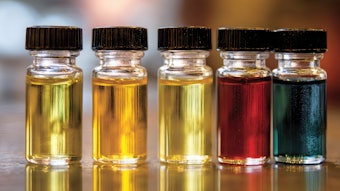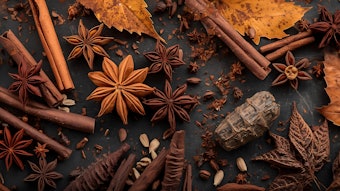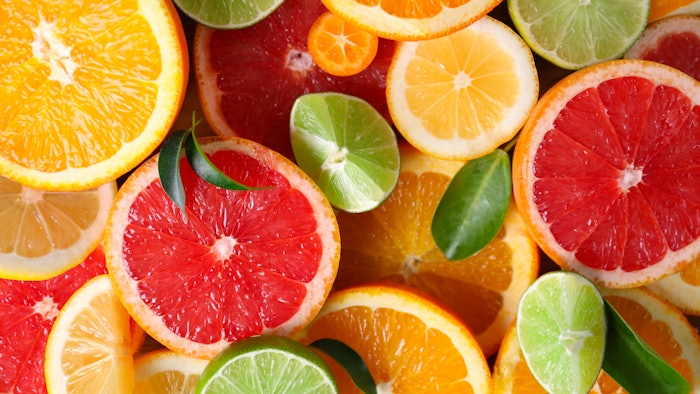
Nerol, (2Z)-3,7-dimethyl octa-2,6-dien-1-ol, (FEMA GRAS #2770, CAS #106-25-2) is for many flavorists a quintessential floral note for fruit flavors. The obvious comparisons are with citronellol and geraniol, both of which have strong aspects in a floral context. Nerol also has a dominant rose note, but this is enhanced by a slightly harsh edge. This may not make it the perfect starting point for rose flavors, but it can work well in many fruit flavors. In some flavors the best effect can be obtained by a careful blend of nerol and geraniol.
Note that the dose rates given throughout this article are the levels suggested for use in flavors intended to be dosed at 0.05% in ready-to-drink beverages or in a simple bouillon.
Citrus Flavors
Grapefruit: The effect of this ingredient in grapefruit flavors is fairly subtle, but it does improve authenticity at 20 ppm.
Kalamansi: Amongst a slew of more recently interesting flavors, kalamansi stands out. One hundred ppm of nerol is an interesting addition to kalamansi flavors.
Lemon: Nerol offers a number of positive effects in lemon flavors. It blends well with neryl acetate and also softens citral. Two hundred ppm is a good level in respect of these two parameters. Nerol can also help a little to reduce the impact of citral oxidation by oxidizing itself to neral. One thousand ppm is a better level for this effect.
Mandarin and Tangerine: Both mandarin and tangerine flavors gain from moderate additions of nerol. One hundred ppm is very effective.
Orange: Nerol can broaden the character of all orange flavors and enhance realism significantly. Levels vary, but 80 ppm is a good place to start.
Fruit Flavors
Apricot: Linalool is the most important floral note in all styles of apricot flavors. Nerol plays a supporting role, but can enhance the floral complex at levels of addition in the region of 500 ppm.
Blackberry: Ten ppm of this raw material has an interesting effect in authentic blackberry flavors, balancing some of the musk profile.
Blueberry: Linalool also has a big part to play in all blueberry flavors. Again, nerol is secondary, enhancing the floral notes at 500 ppm.
Cherry: Nerol is interesting in all cherry flavors. It adds to the more realistic styles, but also helps soften benzaldehyde dominated confection. Five hundred ppm is ideal in both styles.
Cranberry: The floral character of cranberry flavors is quietly lifted by the very subtle addition of 20 ppm of neral. Neral can add to the subtle floral notes of cranberry applications.ira_kalinicheva at Adobe Stock
Neral can add to the subtle floral notes of cranberry applications.ira_kalinicheva at Adobe Stock
Grape, Concord: Nerol introduces an obvious floral note into Concord grape flavors at 1,000 ppm, but the effect is entirely positive.
Lychee: The floral character of rose dominates good lychee flavors, but care should be taken to prevent a single ingredient, especially citronellol, sticking out. Nerol and geraniol both help in this regard. The best level for nerol is 1,000 ppm.
Peach and Nectarine: Nerol is less important in peach and nectarine flavors than in apricot flavors because the overall floral note is less prominent. One hundred ppm works well.
Raspberry: Nerol is quite effective in raspberry flavors because it has some affinity to damascenone. Levels of addition are pretty much at creative discretion, ranging from 100 to 1,000 ppm.
Strawberry: Nerol is not a good addition for all strawberry flavors. It does enhance the profile of ripe strawberry flavors. One hundred ppm is a good starting level.
Tamarind: Nerol provides a very compatible floral lift to tamarind flavors. Levels vary, depending on the effect desired, but 1,000 ppm works very well.
Floral Flavors
Elderflower: Hotrienol has an obvious odor connection to linalool but is more bright and sharp. Two hundred ppm of nerol helps to push things in the right direction.
Neroli: Authenticity is the main benefit from adding a touch of nerol to neroli flavors. Levels are only limited by the imagination, starting at 200 ppm.
Rose: In a creatively ideal world, a combination of rose otto and rose de mai absolute would make a perfect rose flavor. Sadly, cost intervenes and we always need to make economies. Citronellol is the lead ingredient, but nerol has a very useful modifying role at 5,000 ppm.
 Nerol in combination with geraniol can help address the challenge of ginger flavors.Pixel-Shot at Adobe Stock
Nerol in combination with geraniol can help address the challenge of ginger flavors.Pixel-Shot at Adobe Stock
Other Flavors
Ginger: Ginger flavors are often an interesting challenge. Lifting the profile without diminishing the specific ginger character is not so easy. Nerol can help, often in conjunction with geraniol. Five hundred ppm is a good level to shoot for.
Honey: Honey flavors are very varied, many with a strong floral note. Nerol can be interesting in many styles, starting at 1,000 ppm.
Tea, Black: Nerol is distinctly more compatible with black tea flavors than with green tea flavors. Two thousand ppm can enhance the perception of a good quality, high grown black tea.
Tomato, Ripe: The impact of this ingredient in tomato flavors is to increase depth and ripeness, both attractive characteristics.
